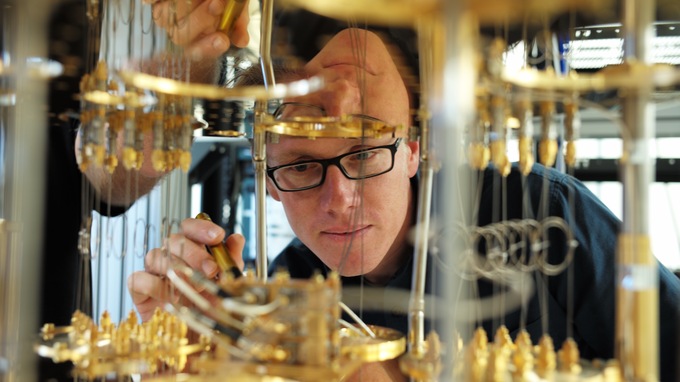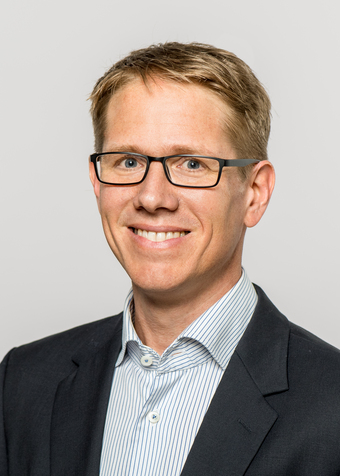Ein Baumeister für Quantencomputer
Prof. Stefan Filipp neu am Physik-Department und am Walther-Meißner-Institut
2020-06-30 – Nachrichten aus dem Physik-Department
Die Wände sind noch kahl, es riecht nach Farbe. Im Büro stehen unausgepackte Umzugskartons. Auf dem Schreibtisch wirkt das Notebook etwas verlassen und in der Besprechungsecke stehen behelfsmäßig zwei Stühle um den runden Tisch. Corona-bedingt hat der neue Leiter des Walther-Meißner-Instituts (WMI) seine Stelle ein paar Wochen später als geplant angetreten. Neugierig und voller Erwartung blickt Stefan Filipp dennoch auf den Job, den er als Leiter des Instituts für Tieftemperaturforschung seit wenigen Tagen innehat.
Von Zürich nach München hat es ihn nicht nur gezogen, weil es ihn, seine Frau und seine vier Kinder der Wiener Heimat ein wenig näher bringt. Und natürlich will er auch dem Quantencomputer in München auf die Sprünge helfen. Mit Quantenphänomenen hat Stefan Filipp sich schon lange beschäftigt. Während seines Studiums stand die Bell-Ungleichung hoch im Kurs; doch gab es kaum Vorlesungen dazu. Anton Zeilingers Experimente und ein Seminar über Quantenphysik und Verschränkung hinterließen Spuren: Fasziniert entdeckte Filipp, dass man mit Lasern sehr schöne Experimente mit Photonen machen konnte. Doch ging es ihm schnell nicht so sehr darum, die Physik zu erklären. Vielmehr war er von der Idee berauscht, was man daraus machen kann. In der Anwendung, also in den Quantencomputern sah er, dass sie das Potenzial haben, tatsächlich was wirklich Neues zu bewirken. Die Idee, da selbst etwas dazu beitragen zu können, spornte Stefan Filipp an, sich weiter mit Quantenphänomen zu beschäftigen.
Wenn Neutronen-Interferometer zum Alltag gehören
Dabei wollte der österreichische Physiker zunächst eher im Bereich der Theoretischen Physik bleiben. Seinen Master hat er in Schweden, im Rahmen eines Erasmusaufenthalts gemacht. Dabei ging es auch um Korrelationen von Quantenzuständen, um sogenannte Geometrische Phasen. Sein weiterer Weg führte Filipp zurück nach Wien, ans Atominstitut zu Professor Rauch. Dort wollte er mit der Theorie weitermachen. Es stellte sich aber ziemlich rasch heraus, dass es kaum möglich war, sich an einem experimentellen Institut ausschließlich mit Theorie zu beschäftigen. Früher oder später muss also jeder Wissenschaftler dort dann doch auch selbst mal Hand anlegen an die Experimente.
So gehörte plötzlich ein Neutronen-Interferometer zum Alltag von Stefan Filipp. Er bestrahlte Silizium-Einkristalle mit Neutronen. Dabei wird der Strahl gebrochen und lässt sich wieder vereinen. Bei diesen Interferometrie-Experimenten misst man Peaks oder eben auch nicht, je nachdem, nach welchem Interferenzmuster das Experiment aufgebaut wurde. Faszinierend war für Filipp dabei, dass man tatsächlich im Messapparat Quantenphänomene betrachten konnte. Zweifellos sind bei solchen Experimenten viele Schritte hart erkämpft. „Aber wenn sich dann alles zusammenfügt, man das Experiment im Kasten hat und man am Computerbildschirm die Daten auftauchen sieht, die zeigen, was man eigentlich vermutet hat, ist es ein schönes Gefühl.“
Von Neutronen zu Photonen und zur Quantenoptik
So blieb Stefan Filipp beim Schrauben und Kabellegen und experimentierte mit ultrakalten Neutronen. So recht überzeugen konnten diese Einteilchensysteme ihn aber nicht. Neutronen als Einteilchensysteme waren jedoch nicht so überzeugend für praktikable Quanteninformationsverarbeitung. Und so führte ihn die Suche nach viel- und zukunftsversprechenden Forschungsgegenständen an die ETH Zürich zu Andreas Wallraff. Dort liefen erste Experimente in der Quantenoptik, bei denen man einzelne Qubits, einzelne supraleitende Schaltkreise und Photonen koppelte. Im Grunde handelte es sich dabei bereits um die zweite Generation der Experimente mit Qubits. Begonnen hatten sie in Yale mit Robert J. Schoelkopf und mit John Martinis in Santa Barbara. Wallraff war Postdoc bei Schoelkopf und führte Experimente an der ETH weiter. Waren es damals ungefähr zehn Gruppen, die auf dem Gebiet arbeiteten, gibt es inzwischen einige mehr und längst ist die Industrie auf den Zug aufgesprungen. IBM war schon recht früh dabei und hat mit Mattias Steffen und Jerry Chow, die von Schoelkopf und Martini kommen, eine Gruppe aufgebaut, die sehr aktiv funktionierende Quantencomputern bauen.
Ein Forschungs-Quantencomputer in München
In der Vermarktung von Quantencomputern kann und soll Filipps Gruppe in München zwar nicht konkurrieren. Vielmehr geht es darum, Möglichkeiten zu finden, das System selbst zu verbessern. „Die Vision wäre, ein System zu bauen, das hinreichend groß ist - das müssen aber vorerst keine Hundert, Tausend oder Millionen Qubits sein. Aber ein System mit zehn, 20 oder 30 Qubits soll es schon werden und wenn die Ressourcen stimmen vielleicht auch mehr.“ Diese Größe bräuchte man laut Filipp, um zu verstehen, wie so ein System funktioniert. Das war schließlich mit einer der Gründe, den Weg ans WMI nach Garching einzuschlagen. Der österreichische Quanten-Experte will sich keineswegs nur mit Engineering rund um den neuartigen Supercomputer befassen, was bei IBM der Schwerpunkt seiner Arbeit war. Vielmehr ist er neugierig, verstärkt in die Grundlagenforschung einzusteigen: „Ich will mich weniger von der Anwendung allein antreiben lassen, sondern auch der wissenschaftlichen Neugierde nachgeben“. So könne er der unter anderem der Frage nachgehen, wie neue Qubits, neue Kopplungsmechanismen oder Materialien aussehen könnten. Dafür braucht man Input und Forschung aus verschiedenen Bereichen.
Zweifel, ob sich das alles so realisieren lässt, hat Stefan Filipp nicht. Vielmehr ist er der Überzeugung, dass es an der Universität spannend bleibt. Schließlich könne man sich die Bereiche aussuchen, die man genauer betrachten will. Und selbst wenn es nicht darum geht, einen kommerziellen Quantencomputer zu bauen, hat Filipp keinen Zweifel daran, dass die dahinter steckende Technologie sinnvoll ist und nützlich sein kann, ungeachtet der Frage, welches tatsächlich die erste Anwendung davon sein wird.
Gut vernetzte Quantenwissenschaftler
Allerdings sind gewisse Rahmenbedingungen erforderlich, um ein funktionierendes System aufzubauen. Beim Forschungszentrum von IBM stimmten diese für Filipp. Dort arbeiten viele Leute mit sehr viel Expertise auf einem hohen Niveau zusammen. Beim täglichen Kaffeeplausch in der Cafeteria tauschten sich die Mitarbeiter zwanglos aus. Das ist in München allein schon wegen der Größe des Campus nicht so ohne Weiteres möglich. Dafür gibt es hier aber das MCQST. Dieses bringt zum Beispiel über verschiedene Veranstaltungen Quantenwissenschaftler zusammen und bietet ihnen die Möglichkeit, sich auszutauschen. „Und je besser man sich da vernetzen kann, desto besser man sich in das Ökosystem einfügen kann, um so mehr kann dabei herauskommen,“ ist Filipp überzeugt.
Was Filipp aber mitnimmt nach München, sind die täglichen Fahrten mit seinem Schummel-Fahrrad ins Büro. Musste er im hügeligen Zürich rund 16 km für den Weg zum Institut zurücklegen, sind es in das noch leere Büro im WMI jetzt 20 km – dafür ist die Strecke flach, ideal also für sein E-Bike.
Über Stefan Filipp
Dr. Stefan Filipp ist seit Mai 2020 Professor für Physik an der TU München und Direktor des Walther-Meißner-Instituts der Bayerischen Akademie der Wissenschaften. Zuvor war er bei IBM Research tätig, wo er seit 2014 am Watson Research Center in New York, USA, auf dem Gebiet des supraleitenden Schaltkreis-Quantencomputers arbeitet. Im September 2015 wechselte Stefan zum IBM Research-Laboratorium Zürich. Dort übernahm er die technische Leitung des Teams für supraleitende Qubits.
Bevor er zu IBM ging, arbeitete Filipp von 2008 bis 2014 am Quantum Device Lab der Eidgenössischen Technischen Hochschule (ETH) in Zürich. Er forschte dort an Hybridkavitäts-QED, geometrischen Phasen, Quantenoptik und Quanteninformationsverarbeitung mit supraleitenden Schaltkreisen.
Stefan erhielt 2006 einen Doktortitel (mit Auszeichnung) in Technischer Physik von der Technischen Universität Wien. Für seine Doktorarbeit erhielt er den Victor-Hess-Preis der Österreichischen Physikalischen Gesellschaft.
Seinen Bachelor-Abschluss in Technischer Physik machte er 2003 an der Technischen Universität Wien. Einen Master of Science in Physik erhielt er 2002 von der Universität Uppsala (Schweden).
- Redaktion:
- Margrit Lingner (für MCQST), Dr. Johannes Wiedersich (Physik-Department)
Links
Kontakt
Prof. Dr. Stefan Filipp
und

